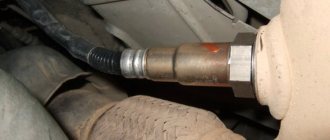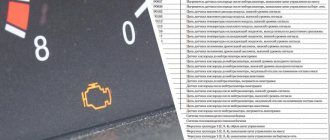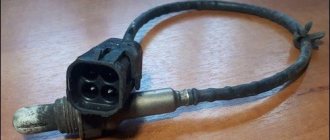What does P0133 mean?
The Engine Control Module (ECM) uses an oxygen sensor to monitor the oxygen content of the vehicle's exhaust gases. The ECM uses the signal received from the oxygen sensor to regulate the fuel/air mixture ratio of the engine. The air-fuel ratio is controlled by the ECM to regulate fuel consumption and reduce emissions of harmful substances from the vehicle's exhaust gases. The oxygen sensor sends a voltage reading to the ECM, thereby reporting the ratio of air and fuel in the engine mixture.
When the amount of oxygen in the exhaust gas changes, the output voltage of the oxygen sensor changes. The output voltage of the oxygen sensor should change instantly, since when you press the gas pedal, the ratio of air and fuel in the mixture supplied to the engine cylinders immediately changes.
When P0133 appears, the engine control module (ECM) has detected that the oxygen sensor output voltage is not changing quickly enough to correct the air-fuel ratio, indicating that the sensor is responding too slowly.
How to fix error code P0133
Code P0133 in most cases occurs due to problems with the oxygen sensor. We recommend following the following algorithm of actions to identify the cause of the error and correct it:
Check the car using a diagnostic scanner for errors. If there are other errors besides P0133, it is recommended to first correct them, then reset the errors with the scanner and check whether P0133 occurs again;- If there is no doubt about the presence of error P0133, then the first step is to ensure the integrity of the catalyst itself. You need to check externally for physical defects and internally. If the catalyst for one reason or another is not suitable for further use, it will need to be replaced;
- Using diagnostic equipment, check what signal voltage is output from the oxygen sensor. It should be about 450 mV when the car ignition is on. When the ignition is turned off, it should be at a level of 150 mV.
- Taking into account the signal voltage data from the sensor obtained at the previous diagnostic point, determine what type of malfunction exists. If the voltage is below 150 mV when the engine is turned off, then most likely the oxygen sensor itself has failed. In this case, it needs to be replaced with a new one, since it is not repairable. If the voltage above 150 mV is significant, then there is an open circuit problem, that is, a wire break. Wiring problems must be identified and corrected.
Please note: If you do not have diagnostic equipment that allows you to take voltage readings from the oxygen sensor, you can simply replace the sensor with a new working one to see if there is a problem with it.
It is worth noting several nuances that should be taken into account when dealing with error P0133:
- If the car where this error occurs uses LPG, you need to make sure that this equipment is configured correctly and the mixture is optimal. It is also worth noting that a problematic gas rail can cause an error on a car with gas equipment;
- One of the reasons for the P0133 error may be problems with the fuel injectors - flush them;
- Some car models refuse to work with analogue sensors and require the installation of only original oxygen sensors;
- In some cases, the error occurs due to improper operation of the crankshaft position sensor;
- Make sure there are no problems with the exhaust system corrugation. On a number of vehicles, the P0133 error will occur if it is burned out.
It is worth noting that error P0133 often occurs on Hyundai vehicles when operating in Russia, especially on older models. It is believed that a car can be “cure” from such an error by flashing the ECU to requirements that are more responsive to Russian road conditions.
Error P0133 itself is not critical. You can use a car with it, but at the same time it will noticeably lose its dynamics and its fuel consumption will increase.
( 18 votes, average: 4.72 out of 5)
Error P0134 – lack of oxygen sensor signal
Error P0135 – oxygen sensor heating power supply circuit open
Related Posts
Causes of error P0133
- Oxygen sensor malfunction
- Intake manifold leakage
- Air intake system leakage
- Short circuit or break in electrical wires related to the oxygen sensor
- Accumulation of soot or carbon deposits on the oxygen sensor, causing the hole used by the sensor to sense the oxygen content of the exhaust gas to become clogged
- Mass air flow sensor dirty
- Incorrect fuel pressure
Causes
In practice, a slow lambda probe response can occur for several different reasons.
It is worth highlighting the main ones:
- contamination of the oxygen sensor;
- node failure;
- violation of the integrity of the controller circuits;
- problems with the fuel pump, injectors, steam traps and other components of the fuel system;
- violation of the tightness of the exhaust and intake manifold;
- damage to wiring and oxidation of contacts;
- violation of pressure indicators in the fuel system;
- contamination of the air flow sensor;
- clogged lambda probe holes due to carbon deposits or soot.
How does a mechanic diagnose a P0133 code?
When diagnosing this error, the mechanic will do the following:
- Visually inspect the electrical wires related to the oxygen sensor for oil contamination and damage.
- Measure the oxygen sensor output voltage using a diagnostic scanner or multimeter
- Visually inspect the oxygen sensor for clogging and excessive soot or carbon accumulation
- Check air intake and vacuum hoses for wear and damage
Carrying out diagnostics
To determine the true cause that led to the appearance of error code P0133, it is necessary to carry out diagnostic measures.
This is done by performing the following procedures:
- Using a multimeter in voltage measurement mode, the parameters of the oxygen sensor at its output are checked.
- The sensor wiring is visually checked for integrity. It is imperative to check whether there are any oil particles or other contaminants on the wires connected to it.
- Visually assess the condition of the sensor housing by removing it from its seat. There should be no traces of overheating, soot, or oil deposits on it.
- Check vacuum hoses and air intakes for leaks and quality of connections.
This is interesting: How to make a car window defroster (anti-ice) with your own hands?
Having detected certain malfunctions, before resetting the error, you will first need to get rid of the very cause of P0133 when reading the ECU with a diagnostic scanner.
Freeze Frame Data
The first step in diagnosis should be to record the freeze frame data associated with P0133. This will show you the operating conditions present when the ECU stored the error.
Wiring Inspection
Once you have the freeze frame data, you should do a simple visual inspection of the oxygen sensor wiring. Look for any frayed, broken or melted wires.
Check the connector for moisture or corrosion. Unfortunately, the oxygen sensor wiring cannot be repaired (unless it is the heater circuit). Therefore, if you find damaged wiring, the sensor will need to be replaced.
Checking for exhaust leaks
Next, start the engine and listen for any exhaust leaks in front of the sensor. Smaller leaks around the exhaust manifold may be more obvious on a cold engine due to thermal expansion. This may also be accompanied by a visual inspection of the exhaust system.
In some rare cases, there are leaks that cannot be heard or seen, but can be detected using a smoke generator installed in the exhaust pipe.
Watch the video on how to make a smoke generator with your own hands:
This shows very small leaks in porous welds that can cause codes related to the oxygen sensor. If leaks are found, repair and clear error codes.
Oxygen sensor test
Once you have checked that the wiring is intact and there are no exhaust leaks, you will need to access the ECU data stream using an OBD2 scanner.
Here you can monitor the voltage coming from the oxygen sensor to the ECU. The voltage should constantly switch between 0 and 1 volt. If the engine is a "V" engine, you can compare bank 1 to bank 2 to see if one shifts faster than the other.
Check the voltage at 2000 rpm, close the throttle quickly, then open it. When the choke closes you should see a voltage close to 0 volts and when it opens again you should see close to 1 volt. All this must happen very quickly, in less than 100 milliseconds.
Again, if you have a dual-cylinder engine, you can compare the two sides to see if one responds more slowly than the other. If the sensor fails the test, replace it.
These tests can also be performed using a digital multimeter. To do this, you will need to find a wiring diagram to determine the purpose of the wires. Also, using the diagram, find and make sure that the sensor has a reliable ground.
Troubleshooting
Having figured out how the error is formed, what provokes it and on what cars it can occur, you need to answer the main question. It concerns how exactly to get rid of the error.
Experts give several recommendations in this regard.
- Using diagnostic equipment in the form of a scanner, check the ECU in deep diagnostic mode. This will open all errors that are in memory. If there are other errors than the one in question, they should be corrected by identifying the causes and then reset. After this, another diagnosis is carried out. It is possible that 0133 was the result of other malfunctions.
- If we are talking about the obvious presence of error P0133 and the reset did not give anything, then you will have to check the condition of the oxygen sensor and the associated components.
- First of all, it is recommended to check the current condition of the catalyst. Make sure there is no internal or external damage. If the integrity of the catalyst is compromised, a new one will need to be installed.
- Using diagnostic equipment, measure the voltage of the signal that comes from the oxygen sensor. This can be done with a regular multimeter set to voltage test mode. When the ignition is turned on, the reading should ideally be around 450 mV. If the ignition is turned off, wait for a reading of approximately 150 mV on the device. If they are different, the sensor needs to be replaced.
- A voltage of less than 150 mV when the engine is turned off supports the theory that the lambda probe is faulty. There is only one solution: replacing it.
- If the voltage is less than 150 mV under the same conditions, there are breaks in the wiring. You need to find them, carry out repairs, or better yet, replace the damaged wiring.
- When the car is equipped with gas equipment, to eliminate the error that appears, you will need to perform the correct settings and select the most suitable mixture. Quite often, it is because of problems with the gas rail that the error in question appears.
- Fuel injectors in the car should be cleaned and washed with special products. Their contamination negatively affects the air-fuel mixture, affects the behavior of the oxygen sensor, and the operation of the latter is ultimately disrupted. This entails the appearance of a corresponding error with code 0133.
- Be sure to check the exhaust system corrugation. Its integrity may be compromised. If the corrugation is burnt out, error P0133 will almost certainly appear until the fault is completely eliminated.
This is interesting: Lambda probe malfunction: signs, symptoms and testing
To summarize, we can say the following. The appearance of error 0133 indicates that there are problems with the oxygen sensor. Its performance is impaired, the device reacts more slowly, which is why the ECU perceives this as an error in the engine’s operation.
The problem is quite common, but not critical. The main trouble is the change in dynamics and the increase in fuel consumption.
Diagnosing a malfunction is not difficult, nor is it difficult to fix it yourself. But sometimes the help of more qualified specialists may be required.
How to decipher error codes
If you have ever seen how a VAZ-2114 is diagnosed using special equipment in a service station, you probably noticed that the error code has 4 digits. In our case, during self-diagnosis, the code includes only 2 numeric characters. In general, the codes mean the following:
- if the number 1 appears, it means the microprocessor is malfunctioning;
- 2 – the operation of the sensor circuit indicating the fuel level in the tank leaves much to be desired;
- 4 – there is too high voltage in the electrical circuit;
- 8 – the voltage, on the contrary, is too low, it is not enough for the VAZ-2114 to operate properly;
- 13 – there is no signal from the indicator of available oxygen;
- 14 – high signal value of the coolant temperature indicator, filled in for efficient operation of the car’s cooling system;
- 15 – this signal, on the contrary, is too low;
- 16 – voltage units in the on-board network are off scale;
- 17 – low voltage values of the on-board network;
- 19 – the signal from the locking component regarding the position of the crankshaft is received incorrectly or untimely;
- 24 – the sensor that records the vehicle speed is faulty;
- 41 – the phase sensor signal is received incorrectly;
- 51 – there are problems in the functioning of the operational product responsible for memorization;
- 53 – it’s time to repair the CO potentiometer;
- 61 – lambda probe does not work.
Lada is not the latest generation car, so sometimes VAZ-2114 errors can add up, and then decoding becomes a real skill. For example, if there are errors 1 and 6, then the total on the screen shows 7. All these numbers are recorded in the memory of the VAZ-2114, they can only be reset manually. How to do this correctly?
- Take the driver's seat and turn on the ignition.
- Without turning off the ignition, disconnect the terminals from the battery device and wait a few seconds.
- Reconnect them.
You will see when the errors disappear, this simple method is convenient because it saves money on going through a special reset procedure at a service station.











